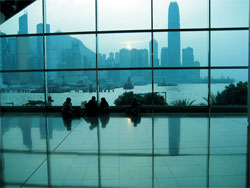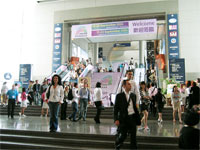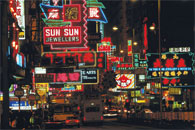The Hong Kong Jewellery & Watch Fair Report
November 12, 06
|
|
By Edahn Golan
Asia’s largest-ever international jewelry fair took place September 18-23 in Hong Kong. The behemoth show was divided between two venues, a new departure for the show. The first day of the show took place at the new location, the AsiaWorld-Expo (AWE), while it was only on the second day that the traditional venue, the Hong Kong Convention & Exhibition Centre (HKCEC), welcomed visitors.
Together, the two venues covered 80,000 square meters of exhibition space and housed over 5,000 exhibition booths and a record number of exhibitors – over 2,500 from 47 countries. Show organizers estimate that over 40,000 visitors attended the fair, 11,000 of them international buyers.
The AWE venue, which lies adjacent to Hong Kong’s inter-national airport, was designed to accommodate growing demand for additional exhibition space. But while the additional room was welcome, some exhibitors hedged their bets by opening booths at both venues.
On the second day of the fair, the main venue, the HKCEC, opened to long sprawling lines at the registration desk. The queues lasted until the late morning hours, as the visitors kept on piling in. While the day was busy for those exhibiting at the HKCEC, the Hong Kong airport venue was virtually empty. This was a trend that characterized the whole show.
Many exhibitors showcased brownish goods – from TTLB to dark tea colors – seemingly in greater numbers than in the past. Fancy colors – mainly yellows and pinks – were as popular as ever.
In terms of design, there seemed to be a move towards more delicate, fine lines, some in intricate designs. White gold was very widespread, much more than yellow gold. Rose gold, seen in many booths, was also popular.
Some booths seemed to be very busy, especially in Hall 1, where many of the local Hong Kong exhibitors were located. In contrast, the Fine Design Pavilion, a high-end diamonds and jewelry pavilion, was unusually quiet, much to the dismay of exhibitors who pay extra for this prime location.
By the third day of the jewelry show, exhibitors were starting to report that business was mixed. With somewhat less quality traffic then last year, many of the buyers were slow to make up their minds, causing a shift in the mood of exhibitors.
|
|
Diamond dealers in the main halls, especially Hall 5 and the adjacent Atrium 2, which hosted many Israeli and Belgian diamond firms, reported decent sales. They said that many local buyers were willing to pay the price, although they were not buying in great numbers. In addition, many of the Jewish and Israeli exhibitors planned to close their booths and leave the fair early due to the Jewish New Year, and feared that they would not see much business. This feeling stemmed from the tendency of many buyers to delay their decisions about what to buy – and at what price – until the closing days.
A clear trend at the 2006 Hong Kong Watch and Jewellery show was a strong demand for smaller goods and certified diamonds. Loose diamond exhibitors reported strong demand for 0.02 carats, as well as 20 to 50 pointers. Demand for certified diamonds had an emphasis on GIA certificates, but IGI and HRD certification was also sought, probably by buyers from outside Hong Kong. An interesting trend in the market was a weakening demand for two carat diamonds, while demand for one carat was strong.
During the show, two pearl auctions were held, as were a number of seminars conducted by international industry organizations, including the Hong Kong Institute of Gemology, the Shanghai Diamond Exchange, the Diamond Trading Company (DTC), GIA, and the Council for Responsible Jewellery Practices (CRJP).
The DTC seminar focused on the challenges lying ahead of the industry in the second half of the year. Speaking at the seminar, DTC Managing Director Varda Shine warned listeners of the need for corporate ethical behavior.
Following Shine’s opening remarks, David Lamb, worldwide marketing director at the DTC, said global consumer demand for diamond jewelry during the first half of the year was marginally weaker compared to 2005. It grew four percent compared to a five percent growth in 2005.
The DTC reported that the second half of the year will see a major media campaign in the U.S. supporting DTC’s Journey program. The Forevermark program, which saw sales of over $75 million in the past two years, will be expanded to Japan, India, and China in the coming months and launched in the Persian Gulf region during 2007.
World Diamond Council President Eli Izhakoff detailed efforts on the consumer confidence front, encouraging the industry to use the new industry web site DiamondFacts.org. “If the emotional value of diamond jewelry is compromised, it will harm us all,” he warned the audience.
|
|
Closing the seminar, Shine returned to the stage to describe the benefits African countries drive from diamond mining. “We are helping governments,” she said, adding that children attend school for free in Botswana thanks to diamonds, and many are receiving health care, including in the battle against HIV.
The Council for Responsible Jewellery Practices (CRJP), which promotes responsible ethical, social, and environmental practices throughout the diamond and gold jewelry supply chain from mine to retail, released its finalized Code of Practices at its presentation at the fair.
The 16-page Code of Practices articulates the ethical, social and environmental practices that the CRJP will expect of its members once its Responsible Practices Framework is fully operational in early 2008.
Despite good sales of diamonds in certain ranges, the general sentiment among exhibitors was one of mixed success. As usual, the bigger companies were very active, busily showing, and selling goods. The smaller companies had to console themselves with the hope that walk-in traffic will result in new clients in the future.


